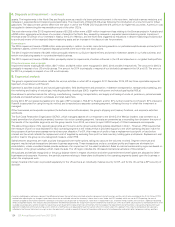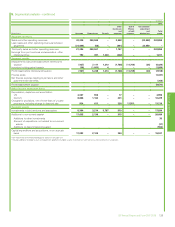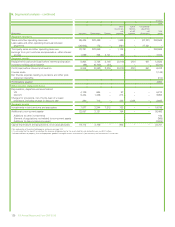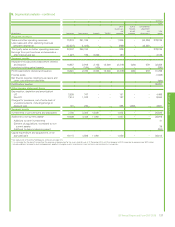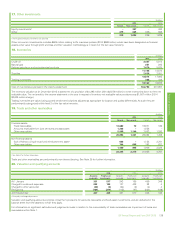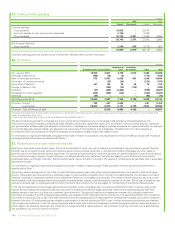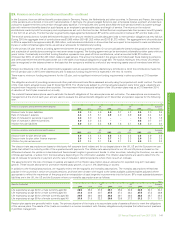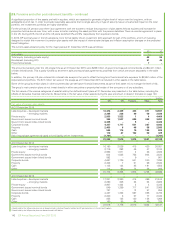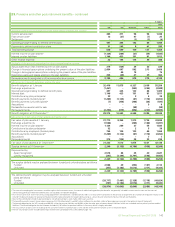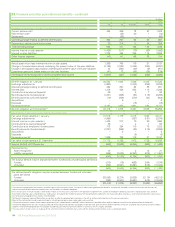BP 2015 Annual Report Download - page 138
Download and view the complete annual report
Please find page 138 of the 2015 BP annual report below. You can navigate through the pages in the report by either clicking on the pages listed below, or by using the keyword search tool below to find specific information within the annual report.
13. Goodwill and impairment review of goodwill
$ million
2015 2014
Cost
At 1 January 12,482 12,851
Exchange adjustments (237) (278)
Acquisitions 573
Deletions (14) (164)
At 31 December 12,236 12,482
Impairment losses
At 1 January 614 670
Deletions (5) (56)
At 31 December 609 614
Net book amount at 31 December 11,627 11,868
Net book amount at 1 January 11,868 12,181
Impairment review of goodwill
$ million
Goodwill at 31 December 2015 2014
Upstream 7,812 7,819
Downstream 3,761 3,968
Other businesses and corporate 54 81
11,627 11,868
Goodwill acquired through business combinations has been allocated to groups of cash-generating units that are expected to benefit from the
synergies of the acquisition. For Upstream, goodwill is allocated to all oil and gas assets in aggregate at the segment level. For Downstream,
goodwill has been allocated to Lubricants and Other.
For information on significant estimates and judgements made in relation to impairments see Impairment of property, plant and equipment,
intangibles and goodwill within Note 1.
Upstream
$ million
2015 2014
Goodwill 7,812 7,819
Excess of recoverable amount over carrying amount 12,894 26,077
The table above shows the carrying amount of goodwill for the segment and the excess of the recoverable amount, based upon a fair value less costs
of disposal calculation, over the carrying amount (the headroom).
The fair value less costs of disposal is based on the cash flows expected to be generated by the projected oil or natural gas production profiles up to
the expected dates of cessation of production of each producing field, based on current estimates of reserves and resources, appropriately risked.
Midstream and supply and trading activities and equity-accounted entities are generally not included in the impairment review of goodwill, because
they are not part of the grouping of cash-generating units to which the goodwill relates and which is used to monitor the goodwill for internal
management purposes. Where such activities form part of a wider Upstream cash-generating unit, they are reflected in the test. The fair value
calculation is based primarily on level 3 inputs as defined by the IFRS 13 ‘Fair value measurement’ hierarchy. As the production profile and related cash
flows can be estimated from BP’s experience, management believes that the estimated cash flows expected to be generated over the life of each field
is the appropriate basis upon which to assess goodwill for impairment. The estimated date of cessation of production depends on the interaction of a
number of variables, such as the recoverable quantities of hydrocarbons, the production profile of the hydrocarbons, the cost of the development of the
infrastructure necessary to recover the hydrocarbons, production costs, the contractual duration of the production concession and the selling price of
the hydrocarbons produced. As each producing field has specific reservoir characteristics and economic circumstances, the cash flows of the fields are
computed using appropriate individual economic models and key assumptions agreed by BP management. Capital expenditure, operating costs and
expected hydrocarbon production profiles are derived from the business segment plan adjusted for assumptions reflecting the price environment at the
time that the test was performed. Estimated production volumes and cash flows up to the date of cessation of production on a field-by-field basis are
developed to be consistent with this. The production profiles used are consistent with the reserve and resource volumes approved as part of BP’s
centrally controlled process for the estimation of proved and probable reserves and total resources. Intangible assets are deemed to have a recoverable
amount equal to their carrying amount.
Consistent with prior years, the 2015 review for impairment was carried out during the fourth quarter. The key assumptions used in the fair value less
costs of disposal calculation are oil and natural gas prices, production volumes and the discount rate. Oil price assumptions for the first five years
reflect the forward market prices at the time that the calculation was prepared. The prices used were, on average, $6.50 per barrel higher than the
prices at the end of the year which are disclosed in Note 1. Gas price assumptions used for the first five years were, on average, the same as those
disclosed in Note 1. Long-term price assumptions and discount rate assumptions used were as disclosed in Note 1. The fair value less costs of
disposal calculations have been prepared solely for the purposes of determining whether the goodwill balance was impaired. Estimated future cash
flows were prepared on the basis of certain assumptions prevailing at the time of the test. The actual outcomes may differ from the assumptions
made. For example, reserves and resources estimates and production forecasts are subject to revision as further technical information becomes
available and economic conditions change, and future commodity prices may differ from the forecasts used in the calculations.
134 BP Annual Report and Form 20-F 2015


